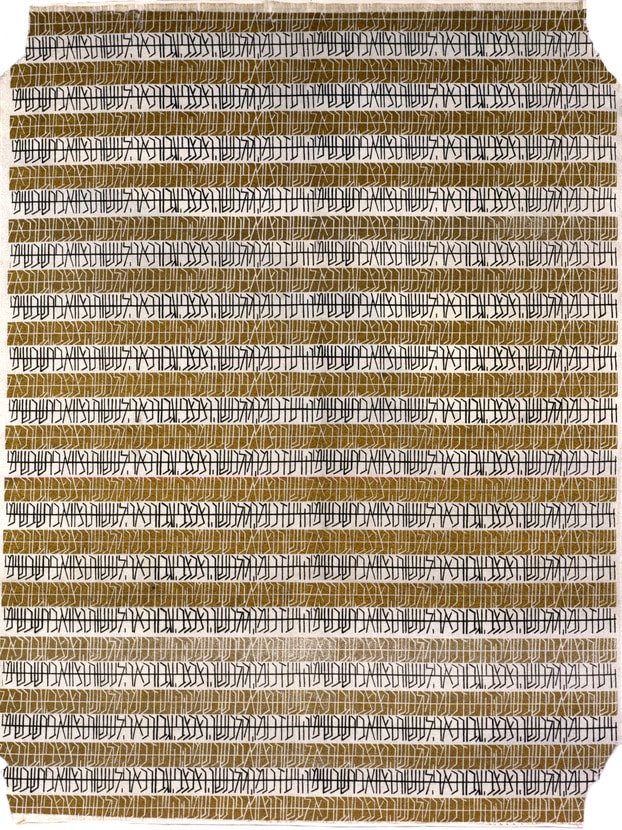
- Object Name:
- Fabric Designed for Synagogue Curtains
- Artist/Maker:
- Ludwig Yehuda Wolpert
- Bio:
- b. 1900, Hildesheim, Germany; d. 1981, New York
- Place Made:
- Larchmont, New York, United States
- Date:
- 1959
- Medium:
- Screenprint on fiberglass
- Dimensions:
- 64 × 48 1/2 in. (162.6 × 123.2 cm)
- Credit Line:
- Gift of Betty Wolpert, widow of the artist
- Accession Number:
- 1992-158
Not On View
Many contemporary Jewish artists have contended with the challenges of creating ceremonial objects that conform to modern aesthetics. The trend first emerged among artists in Europe, who sought to eliminate decoration that served no functional purpose and emphasizing the object's beauty through simplicity in form and line. A pioneer of modern design of Jewish ceremonial art, Ludwig Yehuda Wolpert fulfills the ideals of modernism and the biblical concept "This is my God and I shall adorn Him." Born near Heidelberg, Germany, to a traditional family, Wolpert cherished his Jewish heritage. Originally trained as a sculptor, Wolpert later studied metalwork in Frankfurt with a silversmith who had taught at the Bauhaus.
Wolpert decided to devote himself to the creation of Jewish ceremonial art, applying the new forms and principles of Bauhaus design to his work. After the rise of Nazism, Wolpert immigrated in 1933 to Palestine, where he became professor and director of the metalcraft department at the New Bezalel Academy for Arts and Crafts in Jerusalem. His teaching stressed simplicity and functional purity of design. In 1956, Wolpert helped establish and consequently came to direct the Tobe Pascher Workshop at The Jewish Museum in New York. For many years, this workshop was the only one devoted exclusively to the creation of modern Jewish ceremonial art. When Wolpert began working and teaching at the workshop he began to introduce variety and color into his work with new materials-aluminum, plastics, fabrics, and textiles. Wolpert's designs fit appropriately into the contemporary home and synagogue.
Perhaps Wolpert's greatest contribution is his glorification of the Hebrew letter. As an artist knowledgeable in the Hebrew tradition, he had a kabbalistic love of the Hebrew alphabet. Wolpert's ceremonial objects display imaginative versions of the ancient calligraphy. His use of the letter, combined with his knowledge of the appropriate verse, invests his modern designs with an aura of tradition. Wolpert used a frieze-like motif of stylized Hebrew letters as the embellishment of this fiberglass textile, woven for the draperies of the Larchmont Temple in Larchmont, New York. These repeating bands of text are actually a quotation from Ethics of the Fathers (5:23), a treatise of the Mishnah: "Be bold as a leopard, light as an eagle, swift as a deer, and strong as a lion, to do the will of Your Father who is in Heaven." Wolpert reapplied the same design for another fabric in 1959, making fine design accessible to the masses. Wolpert believed that one-of-a-kind objects do not confer special importance, leading him to create designs that permitted reproductions in order to place them within reach of many.
Wolpert decided to devote himself to the creation of Jewish ceremonial art, applying the new forms and principles of Bauhaus design to his work. After the rise of Nazism, Wolpert immigrated in 1933 to Palestine, where he became professor and director of the metalcraft department at the New Bezalel Academy for Arts and Crafts in Jerusalem. His teaching stressed simplicity and functional purity of design. In 1956, Wolpert helped establish and consequently came to direct the Tobe Pascher Workshop at The Jewish Museum in New York. For many years, this workshop was the only one devoted exclusively to the creation of modern Jewish ceremonial art. When Wolpert began working and teaching at the workshop he began to introduce variety and color into his work with new materials-aluminum, plastics, fabrics, and textiles. Wolpert's designs fit appropriately into the contemporary home and synagogue.
Perhaps Wolpert's greatest contribution is his glorification of the Hebrew letter. As an artist knowledgeable in the Hebrew tradition, he had a kabbalistic love of the Hebrew alphabet. Wolpert's ceremonial objects display imaginative versions of the ancient calligraphy. His use of the letter, combined with his knowledge of the appropriate verse, invests his modern designs with an aura of tradition. Wolpert used a frieze-like motif of stylized Hebrew letters as the embellishment of this fiberglass textile, woven for the draperies of the Larchmont Temple in Larchmont, New York. These repeating bands of text are actually a quotation from Ethics of the Fathers (5:23), a treatise of the Mishnah: "Be bold as a leopard, light as an eagle, swift as a deer, and strong as a lion, to do the will of Your Father who is in Heaven." Wolpert reapplied the same design for another fabric in 1959, making fine design accessible to the masses. Wolpert believed that one-of-a-kind objects do not confer special importance, leading him to create designs that permitted reproductions in order to place them within reach of many.
Information may change as a result of ongoing research.